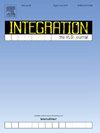A high isolation 16–19 GHz down-conversion mixer in 0.18-μm SiGe Bi-CMOS
IF 2.2
3区 工程技术
Q3 COMPUTER SCIENCE, HARDWARE & ARCHITECTURE
引用次数: 0
Abstract
This paper introduces a novel down-conversion mixer chip explicitly designed for low-orbit satellites operating in the K-band frequency range (16–19 GHz). The chip, fabricated using TSMC's 0.18-μm SiGe Bi-CMOS technology, offers a unique combination of MOS and HBT bipolar junction transistors (BJTs). The double-balanced mixer uses Marchand baluns on the RF and LO ports to convert single-ended signals to differential ones. Transformer coupling between the RF transconductance and LO switching stages ensures excellent isolation and linearity. The proposed series-parallel switching stage effectively increases the switching current at frequencies above 10 GHz and improves the conversion gain at low voltages. The measured results for the proposed mixer demonstrate a power conversion gain of 3.4–4.7 dB with a flat variation of ±0.7 dB and an input third-order intercept point (IIP3) ranging from −1.8 to 0 dBm. These results indicate the performance of the mixer in terms of power gain and linearity. The isolation of RF-to-LO, RF-to-IF, and LO-to-IF are 60, 62, and 30 dB at 19 GHz, respectively, which is crucial for preventing signal interference. The total DC power consumption for 1.1/1 V dual voltage with output buffer is 16.6 mW. The total chip size is 1.11 × 0.843 mm2.
高隔离16-19 GHz下变频混频器,0.18 μm SiGe Bi-CMOS
本文介绍了一种专为k波段(16 - 19ghz)低轨卫星设计的新型下变频混频器芯片。该芯片采用台积电0.18 μm SiGe Bi-CMOS技术制造,提供了MOS和HBT双极结晶体管(bjt)的独特组合。双平衡混频器在RF和LO端口上使用马尔尚均衡器将单端信号转换为差分信号。RF跨导和LO开关级之间的变压器耦合确保了出色的隔离和线性。所提出的串并联开关级有效地增加了10 GHz以上频率的开关电流,提高了低电压下的转换增益。该混频器的测量结果表明,功率转换增益为3.4-4.7 dB,平滑变化为±0.7 dB,输入三阶截距点(IIP3)范围为−1.8至0 dBm。这些结果表明了混合器在功率增益和线性度方面的性能。在19 GHz时,RF-to-LO、RF-to-IF和LO-to-IF的隔离度分别为60、62和30 dB,这对防止信号干扰至关重要。1.1/1 V双电压带输出缓冲器的直流总功耗为16.6 mW。芯片总尺寸为1.11 × 0.843 mm2。
本文章由计算机程序翻译,如有差异,请以英文原文为准。
求助全文
约1分钟内获得全文
求助全文
来源期刊

Integration-The Vlsi Journal
工程技术-工程:电子与电气
CiteScore
3.80
自引率
5.30%
发文量
107
审稿时长
6 months
期刊介绍:
Integration''s aim is to cover every aspect of the VLSI area, with an emphasis on cross-fertilization between various fields of science, and the design, verification, test and applications of integrated circuits and systems, as well as closely related topics in process and device technologies. Individual issues will feature peer-reviewed tutorials and articles as well as reviews of recent publications. The intended coverage of the journal can be assessed by examining the following (non-exclusive) list of topics:
Specification methods and languages; Analog/Digital Integrated Circuits and Systems; VLSI architectures; Algorithms, methods and tools for modeling, simulation, synthesis and verification of integrated circuits and systems of any complexity; Embedded systems; High-level synthesis for VLSI systems; Logic synthesis and finite automata; Testing, design-for-test and test generation algorithms; Physical design; Formal verification; Algorithms implemented in VLSI systems; Systems engineering; Heterogeneous systems.
 求助内容:
求助内容: 应助结果提醒方式:
应助结果提醒方式:


